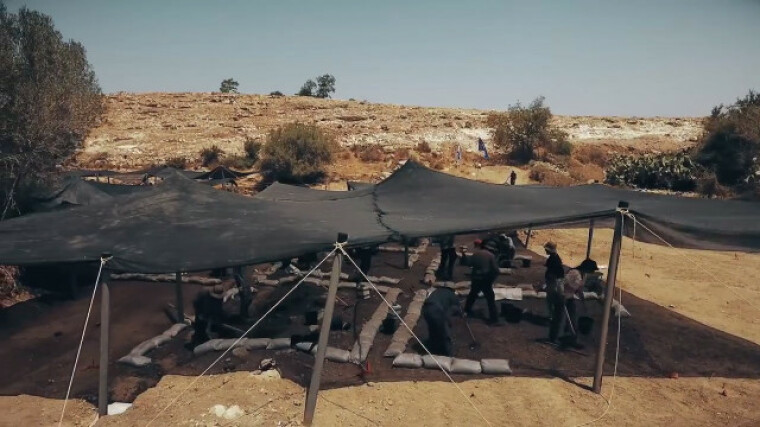Israeli archaeologists discover remains of 1,500-year-old monastery and church near Jerusalem

Israeli Archaeologists have unearthed the remains of a major early Christian church believed to be built in the fourth century A.D. at a site in the town of Beit Shemesh.
Extraordinary mosaics, crucifixes and iconic Christian architecture were discovered by the archaeologists last month after they were called in to survey the site ahead of the expansion of Ramat Beit Shemesh, located some 30 kilometers west of Jerusalem.
With the help of over 1,000 teenage volunteers, the archaeologists uncovered walls built with large, worked stone masonry, as well as several architectural elements, such as a marble pillar decorated with crosses and marble window screens.
Benyamin Storchan, director of the excavation for the Israeli Antiquities Authority, said that the building may have served as a meeting ground for pilgrims.
"We were surprised by the wonderful state of preservation of the ancient remains, and the richness of the finds being uncovered," he said, as reported by The Jerusalem Post.
"The artifacts found in the large building, which seems to be a monastic compound, may indicate that the site was important and perhaps a center for ancient pilgrims in the Judean Shfela [Judean foothills] region," he continued.
During unrelated excavations in the same area, archaeologists have found a major wine-producing installation and an olive oil production facility. Storchan noted that both sites were about a minute's walk from the church and he surmised that the new discovery was the central entity in the area, judging by its splendor.
The diggers and the teenage volunteers found crosses in the form of jewelry, and also on pillar bases and on business stones. Other finds at the site included parts of a chancel screen (a divider), a window post with crosses and incense burners.
The mosaic floor featured birds, which are said to be common in ancient Byzantine stone art, but it also depicted leaves and fruit trees, which Storchan said have "no close parallel in any church uncovered in Israel, Jordan or Syria," adding, "It's a style that is unique to this place."
Storchan noted that the diggers have only uncovered a small portion of a monastery, which was abandoned in the seventh century A.D. for unknown reasons.
He admitted that he has no idea why the church was built at the site, as opposed to any other place in Israel, but he speculated that it could be because an ancient martyr or saint was buried there, or because of a tale from the Old or New Testament.
Teenagers from various organizations, including schools and pre-military associations, have taken part in the excavations since it began last summer.
"We searched for a way to fund-raise for our class trip to Poland, and we decided to take part in the archeological excavations," said Hadas Keich, a 16-year-old student at the Sde Boker Field School.
"Little by little, we uncovered exciting finds here, which helped to connect us to our country and its history. Amazing what is hidden here beneath our feet!" Keich went on to say.
 Christians don't have to affirm transgenderism, but they can’t express that view at work: tribunal
Christians don't have to affirm transgenderism, but they can’t express that view at work: tribunal Archaeology discovery: Medieval Christian prayer beads found on Holy Island
Archaeology discovery: Medieval Christian prayer beads found on Holy Island Presbyterian Church in America votes to leave National Association of Evangelicals
Presbyterian Church in America votes to leave National Association of Evangelicals Over 50 killed in 'vile and satanic' attack at Nigerian church on Pentecost Sunday
Over 50 killed in 'vile and satanic' attack at Nigerian church on Pentecost Sunday Ukrainian Orthodox Church severs ties with Moscow over Patriarch Kirill's support for Putin's war
Ukrainian Orthodox Church severs ties with Moscow over Patriarch Kirill's support for Putin's war Islamic State kills 20 Nigerian Christians as revenge for US airstrike
Islamic State kills 20 Nigerian Christians as revenge for US airstrike Man who served 33 years in prison for murder leads inmates to Christ
Man who served 33 years in prison for murder leads inmates to Christ


 Nigerian student beaten to death, body burned over ‘blasphemous’ WhatsApp message
Nigerian student beaten to death, body burned over ‘blasphemous’ WhatsApp message 'A new low': World reacts after Hong Kong arrests 90-year-old Cardinal Joseph Zen
'A new low': World reacts after Hong Kong arrests 90-year-old Cardinal Joseph Zen Iran sentences Christian man to 10 years in prison for hosting house church worship gathering
Iran sentences Christian man to 10 years in prison for hosting house church worship gathering French Guyana: Pastor shot dead, church set on fire after meeting delegation of Evangelicals
French Guyana: Pastor shot dead, church set on fire after meeting delegation of Evangelicals ‘Talking Jesus’ report finds only 6% of UK adults identify as practicing Christians
‘Talking Jesus’ report finds only 6% of UK adults identify as practicing Christians Mission Eurasia ministry center blown up in Ukraine, hundreds of Bibles destroyed: 'God will provide'
Mission Eurasia ministry center blown up in Ukraine, hundreds of Bibles destroyed: 'God will provide' Church holds service for first time after ISIS desecrated it 8 years ago
Church holds service for first time after ISIS desecrated it 8 years ago Burger King apologizes for 'offensive campaign' using Jesus' words at the Last Supper
Burger King apologizes for 'offensive campaign' using Jesus' words at the Last Supper Uganda: Muslims abduct teacher, burn him inside mosque for praying in Christ’s name
Uganda: Muslims abduct teacher, burn him inside mosque for praying in Christ’s name